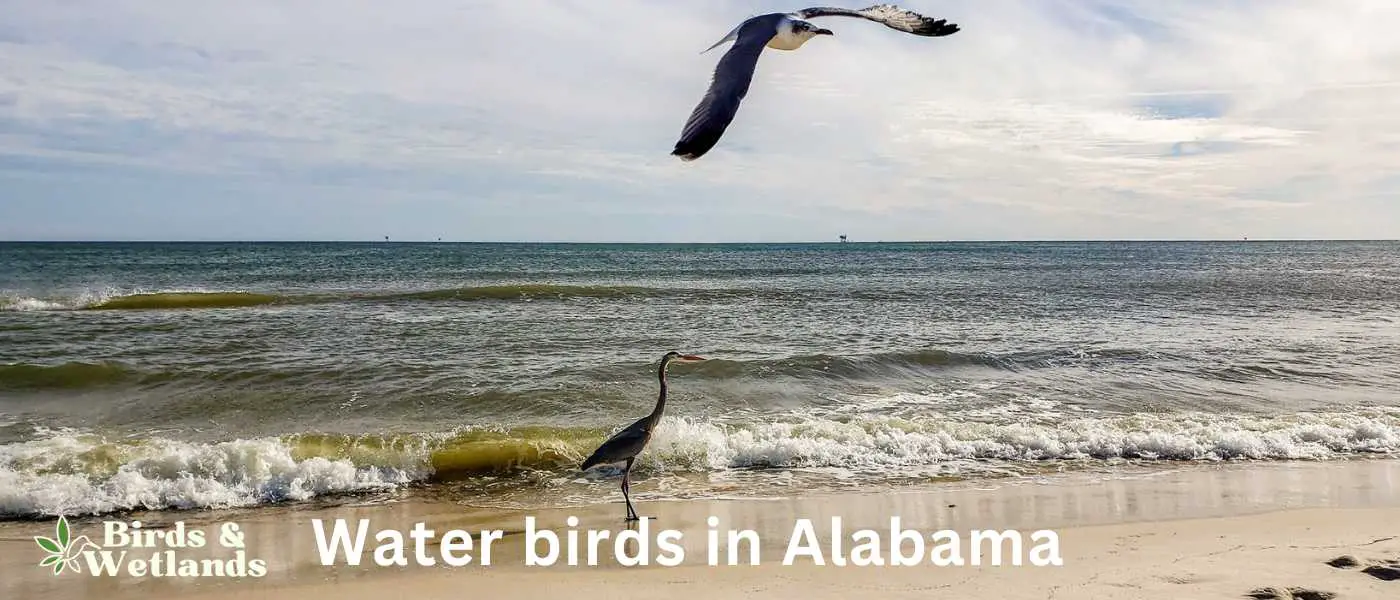Nestled within the breathtaking landscapes of Alabama, a remarkable haven awaits bird enthusiasts and nature lovers alike. Alabama’s abundant water bodies play host to a diverse array of captivating water birds, providing an enchanting spectacle for those who seek to explore the avian wonders of the state.
From graceful herons to vibrant ducks, the world of water birds in Alabama is a vibrant tapestry waiting to be discovered. Get ready to embark on an unforgettable journey through the enchanting world of water birds in Alabama!
Alabama Water Birds
| Common Name | Family | Habitat | Specific Locations in Alabama |
|---|---|---|---|
| Mallard | Ducks | Freshwater Wetlands | Wheeler National Wildlife Refuge |
| Mottled Duck | Ducks | Marshes and Wetlands | Bon Secour National Wildlife Refuge |
| Wood Duck | Ducks | Wooded Swamps | Little River Canyon National Preserve |
| American Wigeon | Ducks | Lakes and Ponds | Wheeler National Wildlife Refuge |
| Ruddy Duck | Ducks | Ponds and Lakes | Guntersville Lake |
| Canvasback | Ducks | Large Lakes and Bays | Wheeler National Wildlife Refuge |
| Redhead | Ducks | Lakes and Ponds | Mobile-Tensaw River Delta |
| Northern Pintail | Ducks | Wetlands | Wheeler National Wildlife Refuge |
| Northern Shoveler | Ducks | Wetlands | Wheeler National Wildlife Refuge |
| Blue-winged Teal | Ducks | Wetlands | Bon Secour National Wildlife Refuge |
| Green-winged Teal | Ducks | Wetlands | Wheeler National Wildlife Refuge |
| Black-bellied Whistling Duck | Ducks | Wetlands and Lakes | Gulf Coast region, particularly Mobile and Baldwin counties |
| Canada Goose | Geese | Wetlands and Lakes | Eufaula National Wildlife Refuge |
| Snow Goose | Geese | Wetlands and Lakes | Wheeler National Wildlife Refuge |
| Common Loon | Loons | Large Lakes and Oceans | Gulf Shores |
| American Coot | Coots | Wetlands and Lakes | Guntersville Lake |
| Yellow Rail | Rails | Wet Meadows and Marshes | Dauphin Island |
| Clapper Rail | Rails | Salt Marshes | Dauphin Island |
| Pied-billed Grebe | Grebes | Ponds and Lakes | Guntersville Lake |
| Horned Grebe | Grebes | Lakes and Oceans | Guntersville Lake |
| American White Pelican | Pelicans | Large Lakes and Coasts | Gulf Coast region, particularly Mobile and Baldwin counties |
| Great Blue Heron | Herons | Wetlands, Marshes, Lakes | Mobile-Tensaw River Delta |
| Green Heron | Herons | Wetlands and Marshes | Bon Secour National Wildlife Refuge |
| Great Egret | Egrets | Wetlands, Marshes, Lakes | Mobile-Tensaw River Delta |
| American White Ibis | Ibises | Wetlands and Marshes | Gulf Shores |
Water Bird Species Found in Alabama
Mallard


| Feature | Measurement |
|---|---|
| Scientific Name | Anas platyrhynchos |
| Length | 20-26 inches |
| Wingspan | 32-39 inches |
| Weight | 1.6-3.5 pounds |
The Mallard, one of the most recognizable of all ducks, is distinguished by its classic “quack” and its common presence in city parks and wild wetlands.
Appearance: Mallards are large ducks with a hefty body and rounded head. The male is notable for its glossy green head, gray body, and black tail-curl, while the female is mottled brown with an orange-brown bill. Both sexes have a white-bordered, blue “speculum” patch in the wing.
Diet: Mallards are omnivorous, dabbling ducks that eat a wide variety of foods. They are known to feed on aquatic vegetation, insects, worms, and grains. In city parks, they are often seen eating bread, popcorn, and other food provided by humans, although such items are not part of their natural diet.
Reproduction: Mallards nest on the ground on dry land that is close to water, under cover of tall grass or other vegetation. The female typically lays around 8 to 13 eggs and incubates them herself.
Mottled Duck
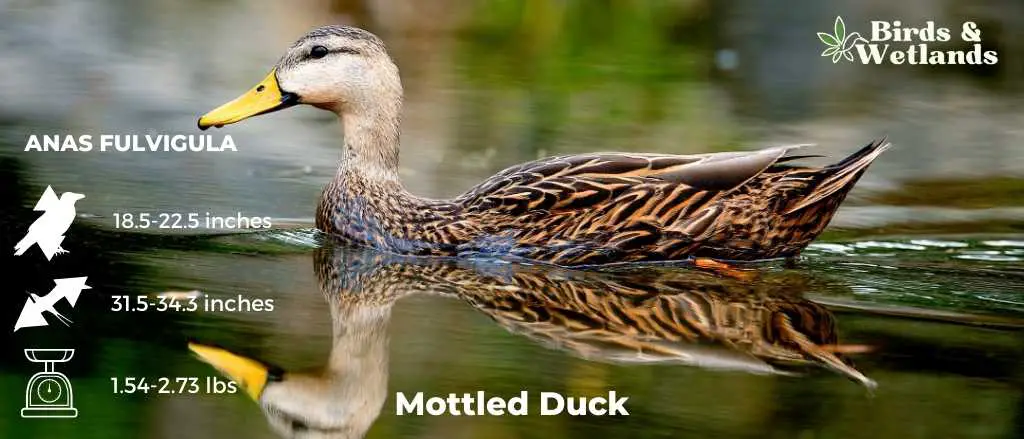
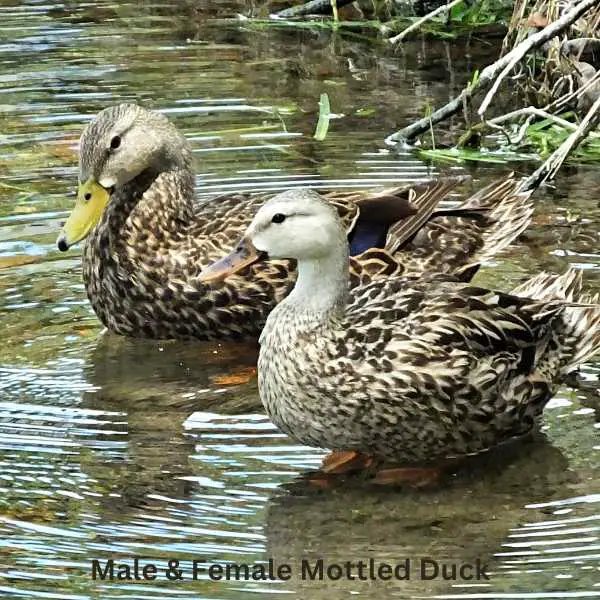
Listen:
Scientific Name: Anas fulvigula
Length: 19.7–22.5 in
Wingspan: 32.7–34.3 in
Weight: 30.9–43.8 oz
The Mottled Duck is a medium-sized waterfowl species known for its subdued coloration and affinity for coastal marshes. It’s primarily found in the southern United States, particularly in Florida and along the Gulf Coast.
Appearance: As the name suggests, Mottled Ducks feature a mottled brown plumage that allows them to blend into their marshy surroundings. They have a fairly uniform color with darker back and lighter underparts. Their bills are yellow to orange, with the males usually sporting a greenish-yellow bill while the females have a more orange one.
Diet: Mottled Ducks are dabbling ducks and they primarily feed on a diet of seeds from aquatic vegetation, grasses, and agricultural crops. They also eat some aquatic insects and crustaceans.
Reproduction: Mottled Ducks pair up for the breeding season and the female typically lays 8 to 10 eggs in a nest hidden in tall grass or reeds. The female incubates the eggs while the male stands guard nearby.
Wood Duck

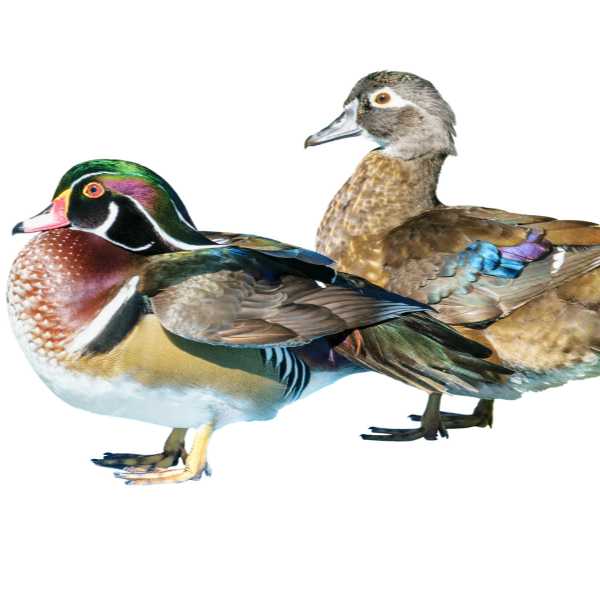
Listen:
Scientific Name: Aix sponsa
Length: 19 to 21 in
Wingspan: 26 to 29 in
Weight: 16.0-30.4 oz
The Wood Duck is an exquisitely colorful waterfowl known for its unique nesting habits and is commonly seen in wooded swamps, marshes, and streams across North America.
Appearance: With their dazzling plumage, Wood Ducks are among the most stunning birds. Males display a multitude of colors, including a green and purple crested head, red eyes, and a white-striped chest, all contrasted with a bronze-colored body. Females, though more subdued with a gray-brown body and white eye-ring, also possess their own charm.
Diet: Wood Ducks have a diverse diet that includes seeds, fruits, and insects, as well as other invertebrates. Their broad diet helps them to adapt to a variety of habitats, whether in the wild or in urban areas with suitable nesting sites.
Reproduction: Unlike most other ducks, Wood Ducks prefer to nest in tree cavities near water, leading to their common name. They will also readily use nest boxes if they’re available. A typical clutch consists of 9 to 14 eggs, which the female incubates alone.
American Wigeon
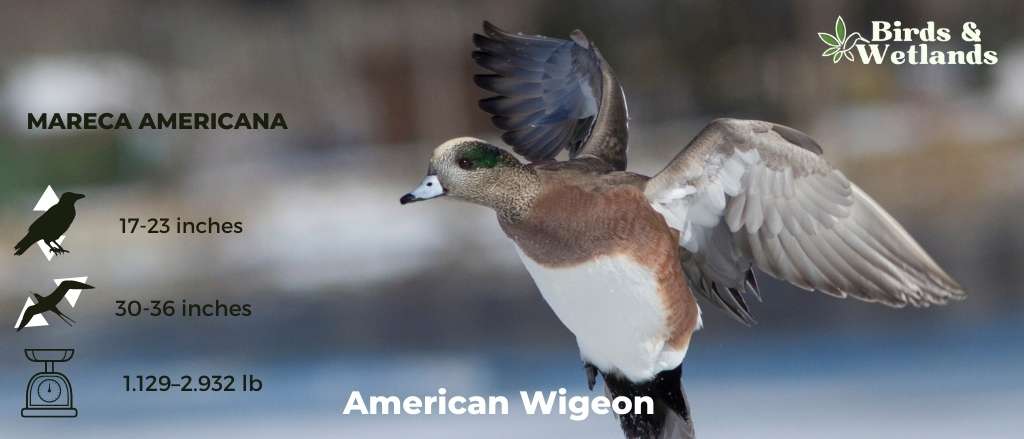
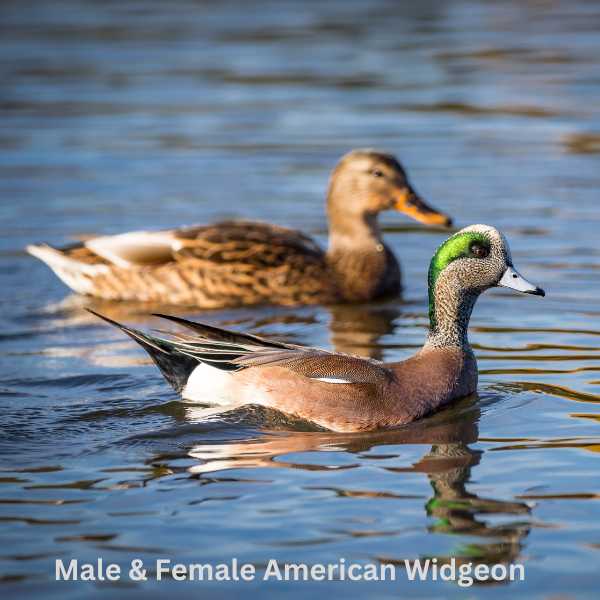
Listen to American Wigeon
Scientific Name: Mareca americana
Length: 17–23 in
Wingspan: 30–36 in
Weight: 1 –3 lb
The American Wigeon is a medium-sized duck species that is a popular sight in wetlands, ponds, and lakes and is often seen in mixed flocks with other ducks.
Males of the species are recognized by their distinctive appearance. They sport a unique white forehead and crown, coupled with a green band stretching from the eye to the back of the head. The body is mainly gray with a pinkish hue on the chest. Females are more subdued in color, with primarily gray and brown tones.
Diet: comprising mainly plant material like aquatic vegetation and grasses, but it also includes insects and other small invertebrates. They are known for a feeding behavior called “kleptoparasitism,” where they often snatch food from other ducks.
American Wigeons usually breed in the northernmost parts of North America. The females create their nests on the ground, often hidden in tall grass near water bodies. They lay a clutch of 6 to 11 eggs which they incubate for about three to four weeks and the ducklings feed on small aquatic invertebrates and aquatic insects.
Ruddy Duck

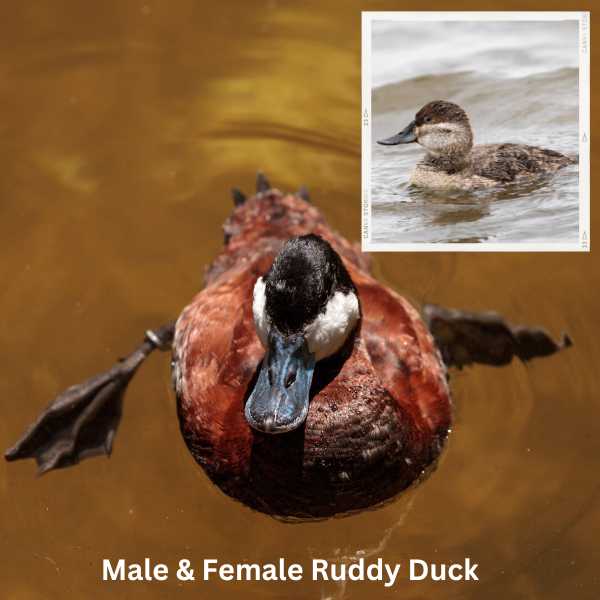
Listen
Scientific Name: Oxyura jamaicensis
Length: 13.8-16.9 in
Wingspan: 22.1-24.4 in
Weight: 10.6-30.0 o
The Ruddy Duck is a compact diving duck species recognized for its bright blue bill and stiff tail that is often held upright. These small, agile birds are found in wetlands and ponds across the United States.
Appearance: Ruddy Ducks are characterized by their distinct reddish-brown plumage, a blackish cap and nape, and a strikingly blue bill in males. The females are less vibrant, with gray-brown feathers and a dark bill. Both genders display a unique, spiky tail that often sticks upright, especially during courtship displays.
Diet: Ruddy Ducks primarily feed on a diet of aquatic invertebrates such as insects, crustaceans, and mollusks. They also consume a variety of aquatic plants and seeds. Their specialized bill allows them to sift through the water and mud to find food.
Reproduction: Ruddy Ducks nest in marshes and ponds with dense vegetation. The female typically lays a clutch of 6 to 10 eggs in a well-concealed nest built from plant material and down.
Canvasback
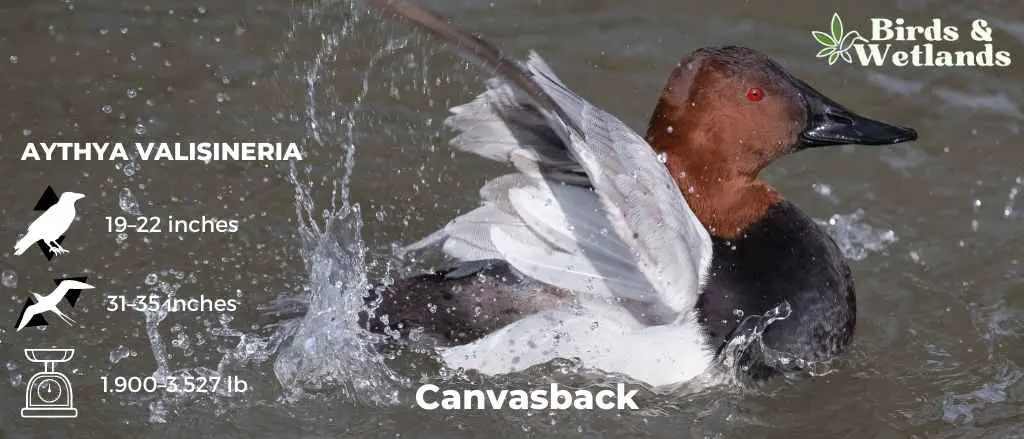

Listen
Scientific Name: Aythya valisineria
Length: 19–22 in
Wingspan: 31–35 in
Weight: 1.900–3.527 lb
The Canvasback is a large diving duck species known for its sloping forehead and long, robust bill. These distinctive birds are primarily found in the wetlands and open water bodies across the United States.
Appearance: Male Canvasbacks are easily recognized by their reddish heads, black chests, and white bodies, which gives the impression of a canvas-like texture, hence their name. Females, on the other hand, have light brown feathers and a slightly paler belly. Both genders have dark gray bills and red eyes.
Diet: Canvasbacks are primarily vegetarian, feeding on aquatic plants like wild celery, pondweeds, and algae. They also occasionally consume small aquatic animals, such as snails, insects, and crustaceans.
Reproduction: Canvasbacks typically nest over water, using marsh plants to construct their nests. The female usually lays a clutch of 5 to 11 eggs which she alone incubates for about a month.
Redhead
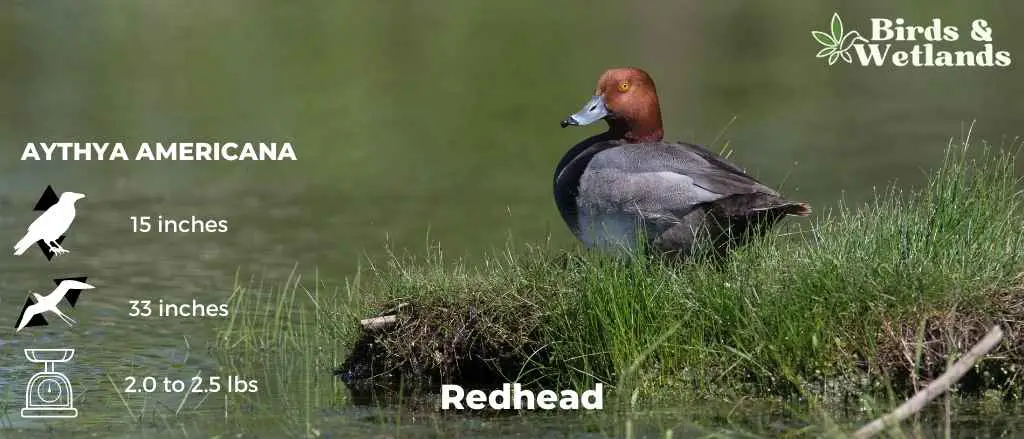

Listen
Scientific Name: Aythya americana
Length: 15 in
Wingspan: 33 in
Weight: 2.0 to 2.5 lbs
The Redhead is a medium-sized diving duck species recognized by its rounded head and broad blue bill. This bird is frequently found in wetlands, ponds, and open water bodies across the United States.
Appearance: The male Redhead is particularly striking, characterized by a coppery red head, black breast, and a gray body. The female is less colorful, featuring a brownish body and a duller, brownish-red head. Both sexes have a prominent blue bill with a black tip.
Diet: Redheads feed on a variety of items, including aquatic plants, seeds, and tubers. They also consume aquatic invertebrates, particularly during the breeding season.
Reproduction: Redheads often nest in marshes and ponds with dense vegetation.Females often lay their eggs in the nests of other ducks, a phenomenon known as brood parasitism. When nesting themselves, the female typically lays a clutch of 7 to 10 eggs and incubates them for about three weeks.
Northern Pintail

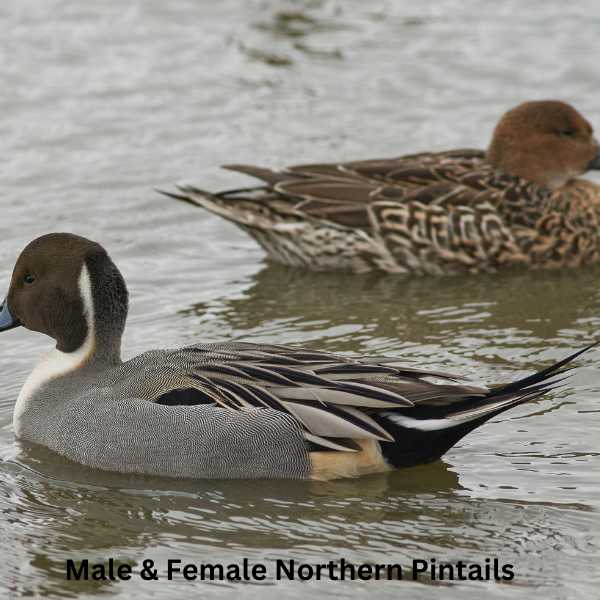
Listen to Northern Pintail
Scientific Name: Anas acuta
Length: 23–30 in
Wingspan: 31–37 in
Weight: 1 –3 lb
The Northern Pintail is a graceful species of duck recognized for their elegance in flight and their sleek bodies and long tails which is pin-shaped.
Male Northern Pintails are celebrated for their distinctive appearance, featuring a chocolate brown head, a white neck, and a grayish body. The most notable characteristic is the long, pointed tail feathers, which give this species its name. Females are more understated in color, sporting a mottled brown plumage.
Diet: Consists primarily of plant matter, including seeds and aquatic vegetation. They are also known to eat insects, especially during the breeding season. The Northern Pintail is often seen dabbling and upending in water bodies to forage for food.
Reproduction: Northern Pintails usually nest on the ground, near water bodies. The female lays a clutch of 7 to 9 eggs and is solely responsible for their incubation, which lasts for about three weeks.
Northern Shoveler

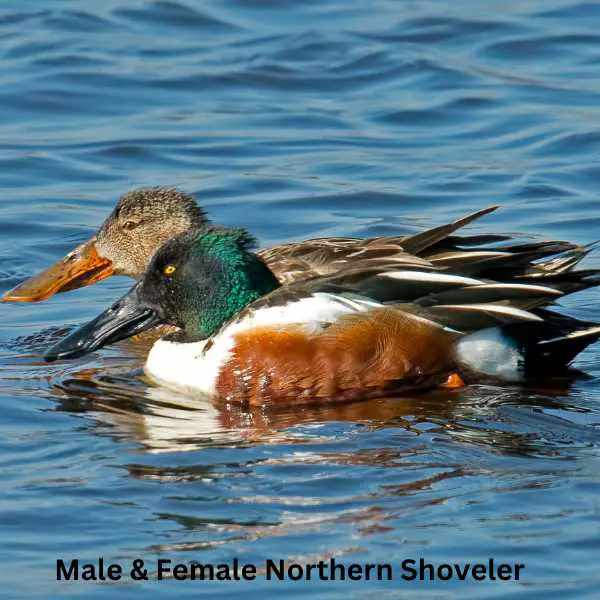
Listen to Northern Shoveler
Scientific Name: Spatula clypeata
Length: 16 in
Wingspan: 22 in
Weight: 14 oz
The Northern Shoveler is a distinct species of dabbling duck celebrated for its long, spoon-shaped bill, a feature that sets it apart from other ducks and gives the bird its name.
Appearance: Male Northern Shovelers are particularly striking, boasting a green head, yellow eyes, a large black bill, and a white chest, complemented by a chestnut-colored body. Females, on the other hand, feature a more muted color scheme, primarily displaying mottled brown feathers across their bodies and a slate-gray bill.
Diet: The Northern Shoveler’s unique bill is perfectly adapted for its feeding habits. The edges of the bill are furnished with comb-like structures that enable the bird to filter food from water. Their diet predominantly consists of aquatic invertebrates and plant matter, including seeds and algae.
Reproduction: Northern Shovelers typically nest on the ground, concealed within dense, grassy areas close to water bodies. The female lays a clutch of about 9 to 12 eggs and is solely responsible for their incubation, which lasts for about three to four weeks.
Blue-winged Teal
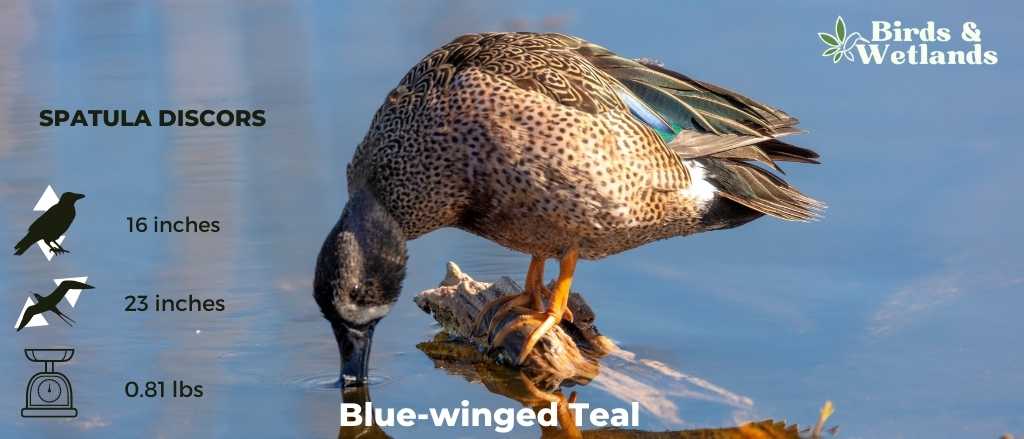

Listen to Blue-winged Teal
Scientific Name: Spatula discors
Length: 16 in
Wingspan: 23 in
Weight: 13 oz
The Blue-winged Teal is a small species of dabbling duck known for its striking plumage and its extensive migratory habits.
Appearance: Male Blue-winged Teals are quite colorful, with a slate gray head and neck, a white crescent in front of the eyes, and a predominantly brown body with specks of black. The name “Blue-winged” comes from the patch of blue feathers visible on their wings during flight. Females, in contrast, are primarily brown and subtly mottled to provide camouflage.
Diet: The Blue-winged Teal feeds mainly on plant matter, such as seeds and aquatic vegetation. However, they also supplement their diet with small invertebrates, especially during the breeding season. They are known for their “dabbling” behavior, where they feed at the surface of the water rather than diving.
Reproduction: Blue-winged Teals prefer to nest on the ground in grassy areas near water. The female typically lays a clutch of 9 to 13 eggs, which she incubates alone for about three weeks. After hatching, the ducklings can feed themselves but remain under the mother’s protection until they are capable of flying.
Green-winged Teal
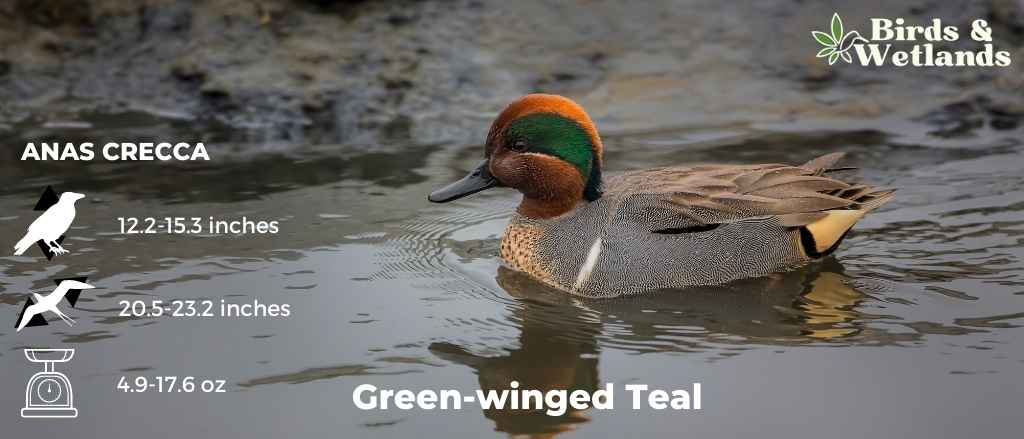
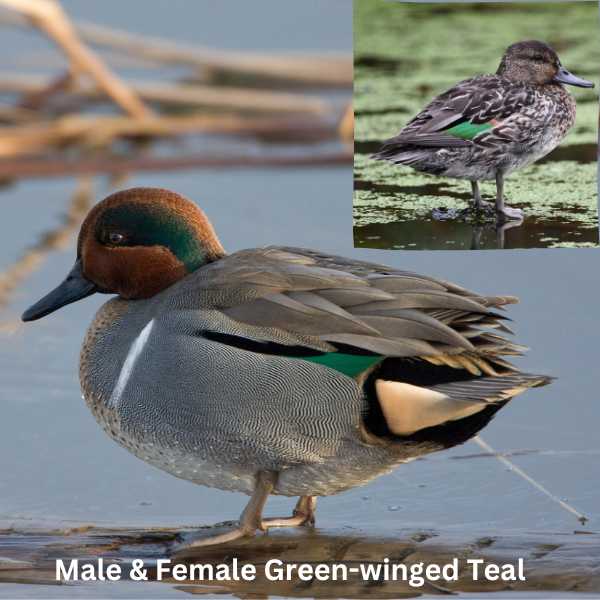
Listen to Green-winged Teal
Scientific Name: Anas crecca
Length: 12.2-15.3 in
Wingspan: 20.5-23.2 in
Weight: 14.9-17.6 oz
The Green-winged Teal is a small species of dabbling duck known for its vibrant coloration and quick, agile flight.
Appearance: Male Green-winged Teals are particularly striking with a chestnut head, a broad green streak running from the eye down the neck, and a speckled chest. The name “Green-winged” originates from the patch of iridescent green feathers visible on their wings. Females are more subtly colored, primarily in mottled brown tones that provide excellent camouflage.
Diet: The Green-winged Teal’s diet consists largely of plant matter such as seeds and aquatic vegetation. They also eat small invertebrates, particularly during the breeding season. These birds are ‘dabblers.’
Reproduction: Green-winged Teals typically nest on the ground, often concealed in dense vegetation near water bodies. The female lays a clutch of about 6 to 9 eggs, which she incubates alone for roughly three weeks.
Black-bellied whistling duck
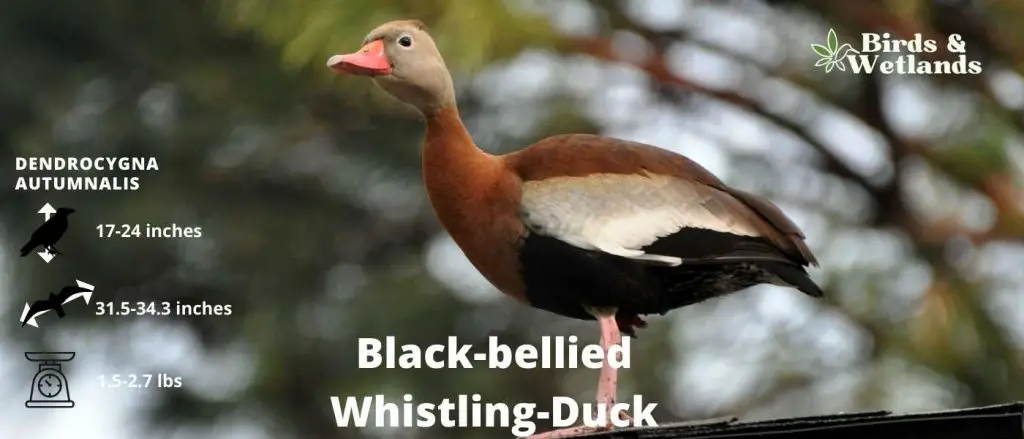

Listen
Scientific Name: Dendrocygna autumnalis
Length: 17-24 inches
Wingspan: 31.5-34.3 in
Weight: 1.5-2.7 lbs
The Black-bellied Whistling Duck is a unique species known for its high-pitched whistling call, and it is one of the few duck species that have strong monogamous relationships.
Appearance: The Black-bellied Whistling Duck is notable for its bright coral-red bill, long pink legs, and its namesake black belly. It has a grey face and chest, and its back is covered with brown feathers that give a scaled appearance. Both males and females share a similar color pattern, making it difficult to distinguish between the two.
Diet: This duck’s diet is mainly vegetarian, consisting predominantly of seeds and grains. They also consume insects, snails, and other small invertebrates. Unlike many other ducks, Black-bellied Whistling Ducks often forage on land, especially at night.
Reproduction: Black-bellied Whistling Ducks usually nest in tree cavities near water, but they will also use nest boxes. The female typically lays between 9 to 16 eggs.
Canada Goose


Canada Goose Sound
Scientific Name: Branta canadensis
Length: 30 to 43 in
Wingspan: 50–73 in
Weight: 5.7–14.3 lb
The Canada Goose is a large, well-known species of waterfowl noted for its distinctive appearance, familiar “honk,” and migratory behavior.
Appearance: Both male and female Canada Geese have a similar appearance, featuring a black head and neck with distinctive white patches on the cheeks and chin. The body is primarily brown with a lighter, often white, underbelly.
Diet: Canada Geese primarily feed on plant matter, including grasses, aquatic vegetation, and grains. They can often be seen grazing in parks, lawns, and fields, as well as dabbling in water bodies.
Reproduction: Canada Geese typically nest on the ground near water bodies, often on islands or other isolated areas to avoid predators. The female lays a clutch of about 4 to 6 eggs, which she incubates alone for around a month.
Snow Goose

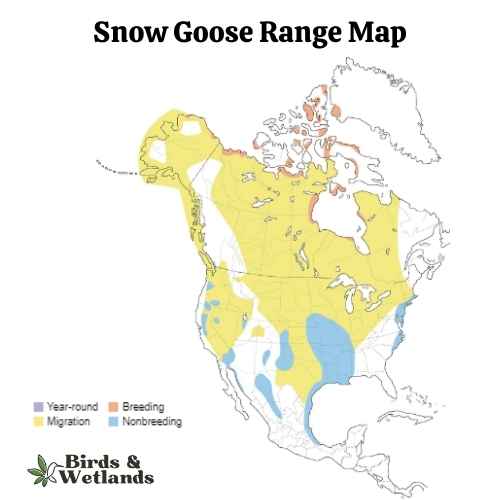
Snow Goose Sound
Scientific Name: Anser caerulescens
Length: 25 to 31 in
Wingspan: 53 to 65 in
Weight: 4.5 to 6.0
The Snow Goose is a large species of waterfowl known for its vibrant white plumage and significant migratory flights.
Appearance: True to their name, Snow Geese are predominantly white with black wingtips. They also have a pink bill, pink legs and feet. A color morph, known as the “Blue Goose,” displays a bluish-gray body with a white head, but is considered the same species.
Diet: Snow Geese primarily feed on plant matter, such as grasses, sedges, and small grains. They can often be seen in large flocks foraging in fields and marshes, and during migration and winter, they can cause considerable damage to agricultural fields due to their feeding habits.
Reproduction: Snow Geese typically nest on the tundra, near water bodies. The female builds the nest and lays a clutch of about 3 to 5 eggs, which she incubates alone for approximately three weeks. Once hatched, the goslings can feed themselves but stay with their parents for protection until they can fly.
Common Loon

Listen:
Scientific Name: Gavia immer
Length: 24-39 in
Wingspan: 50-56 in
Weight: 6.4-13.6 lbs
The Common Loon is a large, iconic water bird that can be found in many parts of North America. It is known for its haunting calls, often heard in the early morning or late evening across the region’s lakes and ponds.
Appearance: The Common Loon is celebrated for its striking black-and-white breeding plumage, a red eye, and a robust, black bill. In winter, its plumage turns to a more subdued gray, but its large, sturdy body and pointed bill remain distinctive.
Diet: Common Loons primarily feed on fish, but also consume crustaceans, frogs, and aquatic insects. They are expert divers, capable of plunging deep underwater to catch their prey, and are often observed popping their heads above water before diving for their next meal.
Reproduction: The Common Loon nests near water, typically on lakes and larger ponds in the northern parts of North America. The female generally lays 1-2 eggs per year in a nest made from vegetation on the ground. Both parents share the responsibility of incubating the eggs and feeding the young.
American Coot

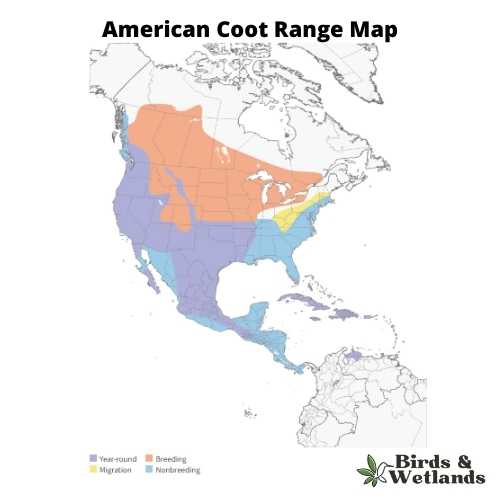
Listen:
Scientific Name: Fulica americana
Length: 13–17 in
Wingspan: 23 to 28 in
Weight: 1.270 to 1.870 lb
The American Coot is a ubiquitous water bird commonly seen in the wetlands, lakes, and ponds of North America, recognized for its adaptability and striking features.
Appearance: American Coots are easily identifiable by their slate-gray bodies, offset by a white, chicken-like bill and a red eye. Their legs are also distinctive, equipped with lobed toes, as opposed to the webbed feet seen in ducks, which assist them in navigating both land and water adeptly.
Diet: While aquatic plants form the bulk of an American Coot’s diet, they aren’t strictly herbivores. These versatile birds also consume small invertebrates and fish, demonstrating their ability to adapt and survive in a variety of habitats.
Reproduction: Nesting for the American Coot usually happens in shallow water bodies, where they construct a floating nest hidden among the vegetation. A clutch can contain between 8 to 12 eggs, all of which are incubated by both parents.
Yellow Rail
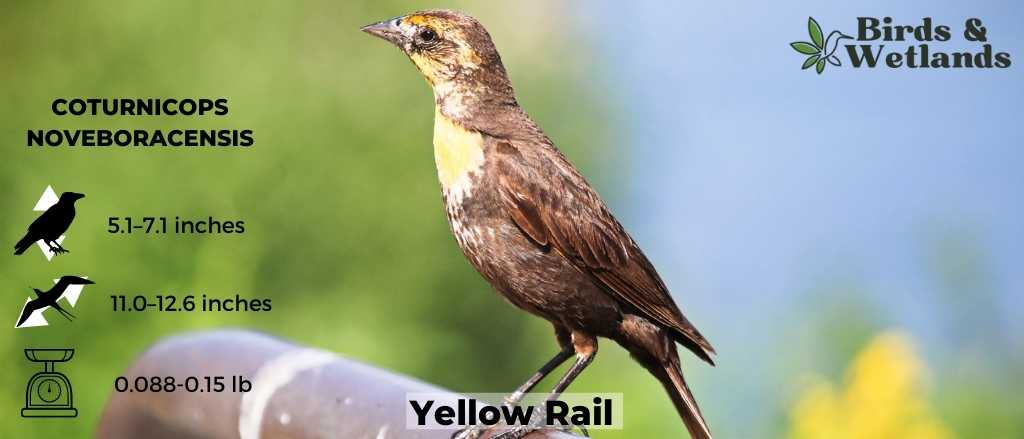

Listen:
Scientific Name: Coturnicops noveboracensis
Length: 5.1–7.1 in
Wingspan: 11.0–12.6 in
Weight: 1.4–2.4 oz
The Yellow Rail is a small and secretive bird species that is more often heard than seen. It is primarily found in the marshy wetlands of the United States, especially in the Midwest and along the Atlantic coast.
Appearance: The Yellow Rail is characterized by its small size, short bill, and short tail. It displays a unique pattern of black, yellow, and white stripes on its back and wings, giving it perfect camouflage among the grasses and reeds in its habitat. Because of their elusive nature and effective camouflage, these birds are often difficult to spot.
Diet: The Yellow Rail primarily feeds on small invertebrates such as insects, spiders, and snails. They also consume seeds and other plant matter. Their feeding habits are largely nocturnal, contributing further to their secretive nature.
Reproduction: Yellow Rails usually nest on the ground in dense, grassy areas of wetlands. The female lays a clutch of 6 to 10 eggs which she incubates for about two weeks.
Clapper Rail

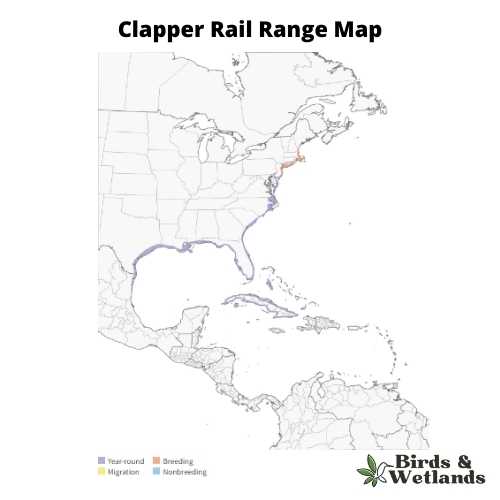
Listen:
Scientific Name: Rallus crepitans
Length: 12.6-16.1 in
Wingspan: 19-21 in
Weight: 9.2-14.1 oz
The Clapper Rail is a large and secretive marsh bird known for its distinctive kek-kek-kek call. Primarily found in saltwater marshes and mangroves in the coastal regions of the United States, the bird is notoriously elusive, often hiding among reeds and grasses.
Appearance: Clapper Rails have long, slightly downward-curving bills and short, powerful wings. Their plumage is a mottled mix of brown, gray, and white, offering the perfect camouflage among the marsh vegetation. They have strong legs and large feet, well adapted for their lifestyle in marshes.
Diet: The diet of Clapper Rails is diverse, consisting of small crustaceans, fish, insects, and various plant matter. These birds forage at the edge of the water, often probing the mud with their bills in search of food.
Reproduction: Clapper Rails build their nests among the tall grasses in the marsh, slightly above the high-water mark. The female lays a clutch of about 4 to 9 eggs, which both parents incubate.
Pied-billed Grebe
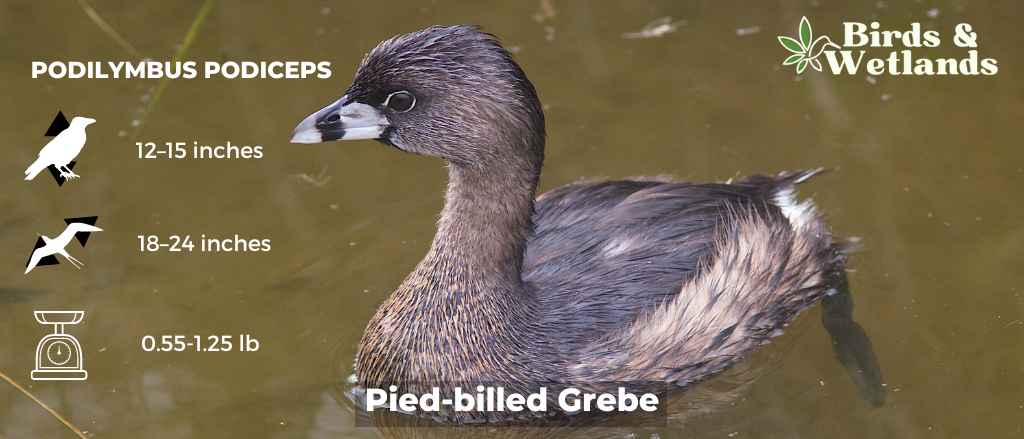
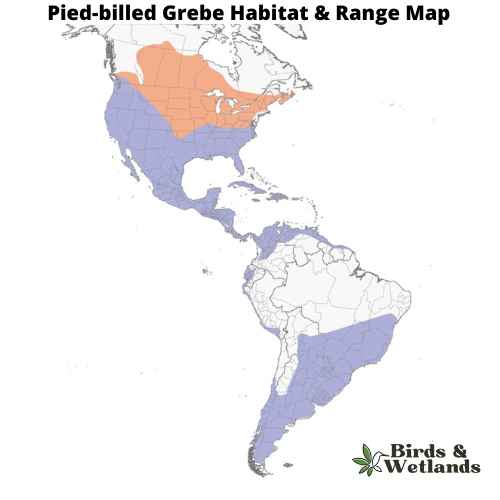
Listen:
Scientific Name: Podilymbus podiceps
Length: 12–15 in
Wingspan: 18–24 in
Weight: 8.9–20.0 oz
The Pied-billed Grebe is a small, elusive water bird well-known for its unique ability to adjust its buoyancy and often “sink” out of sight. It can be found in a wide variety of wetland habitats across the United States.
Appearance: Pied-billed Grebes have a stocky build with a short neck and a chicken-like bill that is conspicuously ringed in black during the breeding season – hence the name “pied-billed”. Their plumage is primarily a muted brown, which can vary in tone depending on the season.
Diet: Their diet consists predominantly of aquatic invertebrates, small fish, and amphibians. Pied-billed Grebes are adept divers and can stay underwater for impressive lengths of time to catch their prey.
Reproduction: Pied-billed Grebes usually nest in dense marsh vegetation, where the female lays 5 to 7 eggs. Both parents share responsibilities for incubation. After hatching, the chicks are often seen riding on their parents’ backs while they learn to navigate their aquatic world.
Horned Grebe (Podiceps auritus)
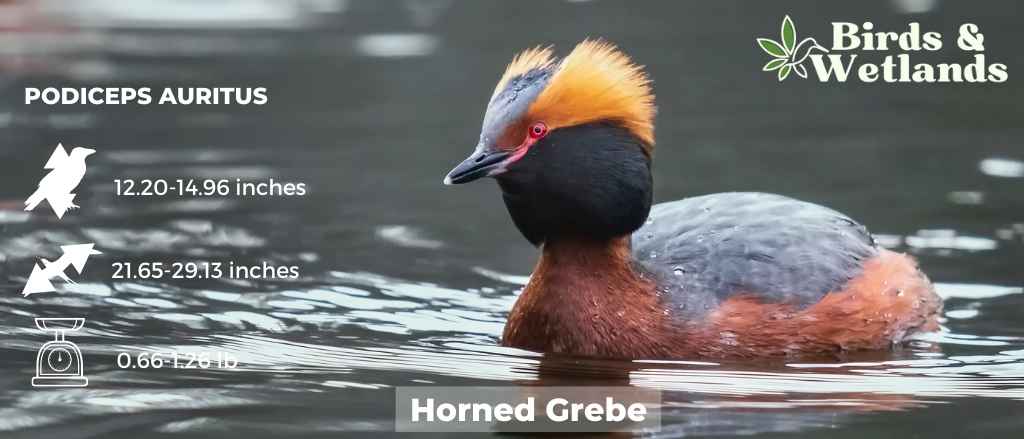
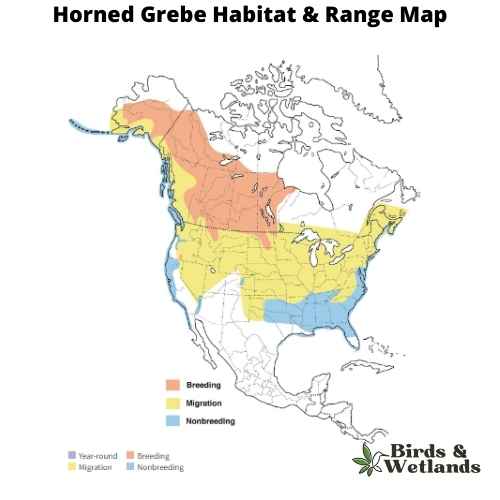
Listen:
Scientific Name: Podiceps auritus
Length: 31–38 cm
Wingspan: 55–74 cm
Weight: 300–570 g
The Horned Grebe is a small water bird well-known for its stunning breeding plumage and distinctive “horns”. Its habitats span across many parts of North America, particularly favoring freshwater lakes and ponds during the breeding season, while winters are spent along sea coasts.
Appearance: In breeding season, the Horned Grebe boasts a vivid red neck, black cheek patches, and an intricate fan of golden feathers behind the eyes that resemble horns – a trait that lends the bird its name. During winter, their plumage turns to a more subdued gray and white. Regardless of the season, their red eyes and stout, pointy bills remain constant.
Diet: The Horned Grebe’s diet is primarily composed of small fish, but it also includes insects, crustaceans, and some vegetation. They’re excellent divers, often disappearing under the water for lengthy periods in search of food.
Reproduction: Horned Grebes build floating nests anchored to aquatic vegetation near the water’s edge. The female typically lays a clutch of 3-8 eggs, and both parents share incubation duties.
American White Pelican


| Feature | Measurement |
|---|---|
| Scientific Name | Pelecanus erythrorhynchos |
| Length | 50–70 in |
| Wingspan | 95–120 in |
| Weight | 3.5 and 13.6 kg |
The American White Pelican (Pelecanus erythrorhynchos) is one of North America’s largest birds, distinguished by its brilliant white plumage, elongated orange bill, and massive wingspan, which can extend up to 3 meters. This bird has a unique appearance with its distinctive pouch used for feeding and a “horn” on the upper part of the bill during the breeding season. Though a large bird, it is very graceful in flight, often seen soaring in flocks in a V formation.
American White Pelicans inhabit lakes, marshes, and salt bays, and despite their size, they are excellent swimmers. They feed primarily on fish, using a cooperative hunting strategy where they encircle schools of fish in shallow water and then scoop them up in their bill pouches. Unlike their brown pelican relatives, they do not dive for their food. During the breeding season, these pelicans will nest in colonies on islands in freshwater lakes.
Great Blue Heron


| Feature | Measurement |
|---|---|
| Scientific Name | Ardea herodias |
| Length | 36–54 in |
| Wingspan | 66–79 in |
| Weight | 1.82–3.6 kgs |
Great Blue Herons are the largest heron species in North America, is distinguished by its tall stature and unique blue-gray plumage.
Measuring up to 4.5 feet tall with a wingspan of approximately 6.5 feet, the bird features a long, pointed bill, a white head with a black eye stripe extending to slender black plumes, and robust, elongated legs. Its distinctive flight pattern, forming a tight “S” shape with its neck, sets it apart from similar large birds, like cranes.
Inhabiting various wetland habitats, including marshes, lakes, rivers, and coastal regions throughout much of North and Central America, the Great Blue Heron is a wading bird. Often seen poised statue-like at the water’s edge, these birds are expert hunters, spearing fish and capturing small animals with their sharp bills.
Green Heron


| Feature | Measurement |
|---|---|
| Scientific Name | Butorides virescens |
| Length | 16-18 inches |
| Wingspan | 25-27 inches |
| Weight | 6-7 ounces |
The Green Heron is a small heron found in North America, notable for its deep green back and chestnut body, as well as its unique fishing tactics.
Appearance: Green Herons are dark and compact birds with a glossy, greenish-black cap, a greenish back and wings, and chestnut neck and belly. The bill is long, dark and sharply pointed. Their legs are bright orange or yellow. Young birds are duller in color, with a dark top and streaked brown front.
Diet: The Green Heron’s diet is quite varied, consisting mostly of small fish, but also includes insects, spiders, and sometimes amphibians and small mammals. It’s known for its tool-using behavior where it drops bait onto the water’s surface to attract fish.
Reproduction: Green Herons are solitary birds except during the breeding season, where they form monogamous pairs. Nests are typically built in trees or shrubs near water. Females lay 2 to 5 pale blue-green eggs that both parents incubate.
Great Egret


| Feature | Measurement |
|---|---|
| Scientific Name | Ardea alba |
| Length | 31 to 41 in |
| Wingspan | 52 to 67 in |
| Weight | 1.5 to 3.3 lbs |
The Great Egret (Ardea alba), also known as the Common Egret, is a large, elegant wading bird recognized for its brilliant white plumage, slender black legs, and long, dagger-like yellow bill.
With a height of up to 3.3 feet and a wingspan of 52 to 67 inches, this bird is amongst the largest of the heron species. Its stately appearance and serene comportment have made it a popular symbol in many cultures and an eye-catching sight in its habitats.
Found across all continents except Antarctica, the Great Egret resides in both fresh and saltwater wetlands, including marshes, ponds, and coastal areas. It feeds mainly on fish, but it also hunts amphibians, small mammals, and invertebrates.
White Ibis (Eudocimus albus)
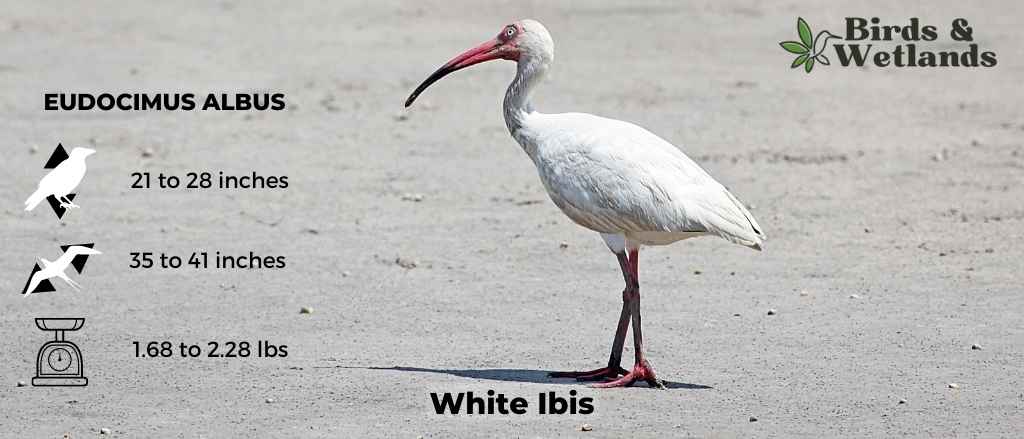
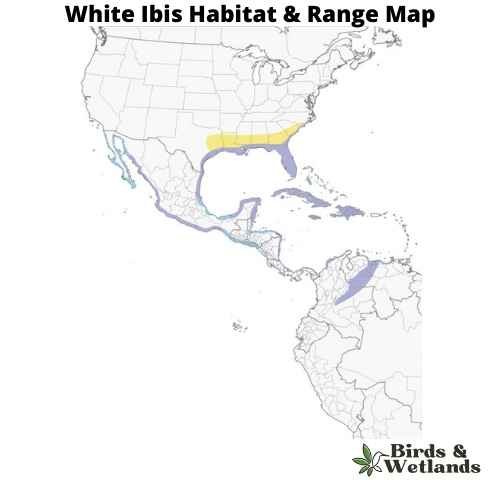
Listen:
Scientific Name: Eudocimus albus
Length: 21 to 28 in
Wingspan: 35 to 41 in
Weight: 1.6 – 2.3lb
The White Ibis is a wading bird renowned for its bright white plumage and distinctive, down-curved bill. It’s most commonly found in the marshes, wetlands, and along the coastlines of the southeastern United States.
Appearance: White Ibises display a predominantly white plumage that’s contrasted by their brilliant red-orange down-curved bill and legs. During the breeding season, the skin on their face may become dark blue. Juvenile White Ibises have brown upper parts and white underparts.
Diet: The diet of the White Ibis primarily consists of various invertebrates, including insects, crayfish, and other small crustaceans. Their long, curved bill is perfectly adapted for probing in mud and shallow water while foraging for food.
Reproduction: White Ibises nest in large colonies, often with other wading birds. The female typically lays 2 to 4 eggs in a nest made of twigs and leaves in trees or shrubs.
Where to Spot Alabama’s Water Birds
Wheeler National Wildlife Refuge: Located along the Tennessee River, Wheeler National Wildlife Refuge is a haven for water birds in Alabama. This expansive refuge offers diverse habitats including wetlands, lakes, and bottomland hardwood forests, attracting a wide variety of species. Look out for Mallards, Wood Ducks, American Wigeons, Northern Shovelers, and Great Blue Herons among the many water bird species that call this refuge home.
Gulf Shores: With its coastal location, Gulf Shores provides an ideal environment for spotting water birds. The beaches, marshes, and lagoons attract an array of species. Keep an eye out for Ruddy Ducks, Green-winged Teals, American White Pelicans, and Great Egrets as you explore this coastal paradise.
Mobile Bay: Mobile Bay is a hotspot for water bird enthusiasts. The expansive bay and its surrounding wetlands offer a rich feeding ground for a diverse range of species. Here, you may encounter Mottled Ducks, American Coots, Clapper Rails, and American White Ibises, among others, as they forage in the marshes and along the shores of the bay.
Wheeler Lake: As part of the Tennessee River system, Wheeler Lake offers another fantastic location for observing water birds. This reservoir attracts numerous species, including Canvasbacks, Pied-billed Grebes, Northern Pintails, and Snow Geese. The lake’s scenic beauty and abundant wildlife make it a prime destination for birdwatchers.
Dauphin Island: Situated on the Gulf of Mexico, Dauphin Island serves as a critical stopover point for migrating water birds. The island’s beaches, mudflats, and marshes provide essential resting and feeding areas. Look for Black-bellied Whistling Ducks, Great Blue Herons, Redheads, and Great Egrets during their migration seasons.
| State | Main Water Bird-Watching Sites |
|---|---|
| Georgia’s Water Birds | Savannah National Wildlife Refuge, Okefenokee Swamp, Harris Neck National Wildlife Refuge |
| Tennessee’s Water Birds | Reelfoot Lake State Park, Radnor Lake State Park, Tennessee National Wildlife Refuge |
| Mississippi’s Water Birds | Noxubee National Wildlife Refuge, Ross Barnett Reservoir, St. Catherine Creek National Wildlife Refuge |
| Florida’s Water Birds | Everglades National Park, Merritt Island National Wildlife Refuge, J.N. ‘Ding’ Darling National Wildlife Refuge |
There are over 100 species of water birds in Alabama, we have just picked the 25 must see ones, but there are plenty of other birds which could beincluded in this list from sandhill cranes, great blue herons, green crested head of the Carolina duck and many other closely related ducks and many more Alabama birds. The American white pelicans with their yellow feet, and many birds which are migrating to central and south america and stop in Alabama on their way.

